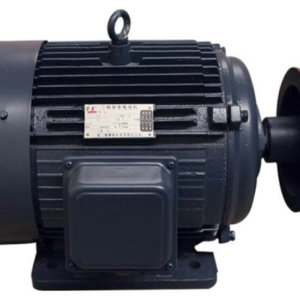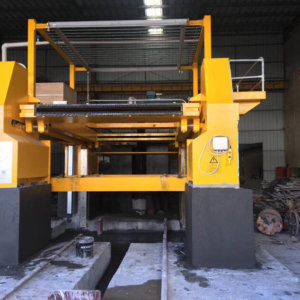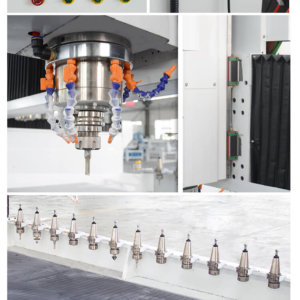1. Introduce of Granite Bridge Saw
2. Types of Granite Bridge Saw Machines
3. Granie Bridge Saw Machine Blade Options
4. Details of Granite Bridge Saw
5. Granite Bridge Saw Specifications
6. Granite Bridge Saw Working Video
Introduce of Granite Bridge Saw
Granite Bridge Saw Machine can also use for cutting marble and quartz and other stone material. This machine is designed with PLC and computer screen system. Thanks to the rotary encoder part and table rotation, granite bridge saw is able to cut quickly and precision. We use good raw materials and reasonable designing on granite bridge saw to make sure machine working in best conditions.We have both Chinese and English language on the computer system for our customers.On the electric cabinet of granite bridge saw,you could see many electric parts like inverter,PLC and other switch. Inverter controls left and right feeding.hydraulic lifting system which equipted through 4 guide post.We have two types of table for granite bridge saw,one is 0-90 degree rotation another one is 0-360 degree rotation. Both of these two tables can tilt & stand up 85 degree for the slab loading and unloading. We can also match a jib crane to work with granite bridge saw machine.
Granite bridge saw machines are indispensable tools in the stone fabrication industry. Their robust structure, precise cutting capabilities, automation features, and diverse applications make them essential for creating high-quality stone products. By understanding the various dimensions of bridge saw machines, audiences can appreciate their complexity and the role they play in the stone fabrication process.

Types of Granite Bridge Saw Machines:
Bridge saw machines come in different variations to cater to specific needs and requirements. Some common types include manual bridge saws, semi-automatic bridge saws, and fully automatic CNC bridge saws. Manual machines require manual adjustments and operator control, while semi-automatic and CNC machines offer varying levels of automation.
Bridge saw machines come in various types, each designed to cater to specific cutting needs and requirements. Here are some common types of bridge saw machines:
1. Manual Bridge Saw:
Manual bridge saw machines are operated manually by the operator. These machines typically have a manual crank or lever system to control the movement of the cutting head along the bridge and the descent of the cutting blade. Manual bridge saws are often used for smaller-scale projects or when budget constraints are a consideration. They require more operator involvement and are suitable for simpler cutting tasks.
2. Semi-Automatic Bridge Saw:
Semi-automatic bridge saw machines combine manual and automated features. These machines feature motorized movement of the cutting head along the bridge, but the operator still controls the cutting process. The operator sets the cutting parameters, such as dimensions and angles, and the machine executes the cuts automatically. Semi-automatic bridge saws offer improved efficiency and accuracy compared to manual saws.
3. CNC Bridge Saw:
CNC (Computer Numerical Control) bridge saw machines are equipped with advanced automation technology. These machines are operated through a computerized control system that allows precise control over cutting parameters. The cutting process is fully automated, with the machine executing programmed cutting sequences. CNC bridge saws offer high precision, versatility, and the ability to handle complex cutting tasks. They are widely used in large-scale stone fabrication facilities.
4. 5-Axis Bridge Saw:
5-axis bridge saw machines are advanced CNC machines that offer enhanced cutting capabilities. In addition to the traditional X, Y, and Z axes, these machines can also tilt and rotate the cutting blade along two additional axes. This enables the machine to perform intricate cuts, bevels, and complex shaping on stone materials. 5-axis bridge saws are commonly used in applications requiring precise and complex cutting, such as curved or multi-dimensional designs.
5. Waterjet Bridge Saw:
Waterjet bridge saw machines combine the cutting power of a traditional bridge saw with the precision and versatility of a waterjet cutting system. These machines use a high-pressure waterjet along with abrasive particles to cut through stone materials. Waterjet technology allows for intricate cutting, smooth edges, and the ability to cut through a wide range of materials, including stone, metal, and glass. Waterjet bridge saws are ideal for applications that require high precision and versatility.
6. Portable Bridge Saw:
Portable bridge saw machines are compact and designed for on-site cutting. These machines are lightweight, easily transportable, and can be set up quickly. They are commonly used for projects that require cutting stone materials at the job site, such as remodeling, renovations, or installations. Portable bridge saws offer convenience, flexibility, and efficient cutting in remote or limited-access locations.
7. Robotic Bridge Saw:
Robotic bridge saw machines utilize robotic arms equipped with cutting tools to perform automated cutting tasks. These machines offer high precision and efficiency and are often used in large-scale stone fabrication facilities. Robotic bridge saws can handle complex cutting patterns, repetitive tasks, and high-volume production. They are typically integrated with computerized control systems for accurate and automated cutting operations.
The choice of bridge saw machine depends on factors such as the scale of production, cutting requirements, complexity of designs, and budget considerations. Understanding the different types of bridge saw machines allows stone fabricators to select the most suitable machine for their specific needs and achieve optimal cutting results.

Granie Bridge Saw Machine Blade Options:
The choice of blade plays a crucial role in achieving desired cutting results. Different blade types and sizes are available to accommodate various materials and cutting requirements. For instance, segmented blades are commonly used for general stone cutting, while continuous rim blades are preferred for delicate materials to minimize chipping.
Blade options play a crucial role in the cutting performance and versatility of bridge saw machines. The choice of the right blade depends on factors such as the type of material being cut, desired cutting speed, finish quality, and overall project requirements. Here are some common blade options used with bridge saw machines:
1. Diamond Blades:
Diamond blades are the most commonly used blades in bridge saw machines. They are made with a steel core and embedded diamond segments on the cutting edge. Diamond blades are highly durable and can cut through a wide range of materials, including natural stone, engineered stone, ceramic, porcelain, and glass. They offer excellent cutting speed and precision, making them suitable for various applications.
2. Segmented Blades:
Segmented blades feature distinct segments with gaps in between. These blades are designed for rough cutting or when faster cutting speed is required. The gaps between segments allow for effective debris removal and cooling during the cutting process. Segmented blades are ideal for initial material breakdown or when the finish quality is not a primary concern.
3. Continuous Rim Blades:
Continuous rim blades have a continuous rim of diamond around the circumference of the blade. These blades provide a smooth and clean cut, making them suitable for applications that require a high-quality finish. Continuous rim blades are commonly used for cutting materials like ceramic, porcelain, and glass, where a precise and chip-free cut is desired.
4. Turbo Blades:
Turbo blades feature a serrated rim design that combines both segmented and continuous rim characteristics. These blades offer a balance between cutting speed and finish quality. The serrated rim helps to dissipate heat during cutting, improving the blade’s cooling and longevity. Turbo blades are versatile and can be used for a variety of materials, including natural stone and engineered stone.
5. Silent Core Blades:
Silent core blades are designed with a specially engineered core that helps reduce noise and vibrations during cutting. They are an ideal choice for environments where noise reduction is essential, such as indoor fabrication facilities or residential areas. Silent core blades provide high cutting performance while minimizing operator fatigue and noise pollution.
6. Bridge Saw Blades for Specific Materials:
There are specialized blades available for specific materials and applications. For instance, there are blades designed specifically for cutting granite, marble, quartzite, limestone, and other stone materials. These blades are optimized to deliver the best cutting performance and longevity for the targeted material. Specialized blades ensure efficient cutting, minimize material waste, and achieve the desired finish quality.
7. Blade Sizes and Configurations:
Bridge saw machines support various blade sizes and configurations to accommodate different cutting needs. Blade sizes typically range from 12 inches to 24 inches or larger, depending on the machine’s capacity. The configuration of the blade, such as the number and arrangement of segments, can also vary. Different configurations offer specific cutting characteristics, such as faster cutting speed, improved debris removal, or enhanced finish quality.
When selecting a blade for a bridge saw machine, it is crucial to consider the material type, thickness, and desired cutting results. It is recommended to consult with blade manufacturers or suppliers who can provide guidance on the most suitable blade options based on the specific cutting requirements. Regular inspection, cleaning, and proper maintenance of the blades are essential to ensure optimal cutting performance and longevity.
Details of Granite Bridge Saw










Granite Bridge Saw Specifications
| Item Name | Unit | Value |
|---|---|---|
| Blade Diameter | mm | 600 |
| Horizontal Travel | mm | 3200 |
| Longitudinal Travel | mm | 3200 |
| Vertical Travel | mm | 300 |
| Main Motor | KW | 18.5 |
| Total Power | KW | 21.5 |
| Size of table | mm | 3200*2000 |
| Table Rotation | n° | 90 |
| Machine overall | mm | 6000*5000*2800 |
| Weight | T | 5.6 |




















